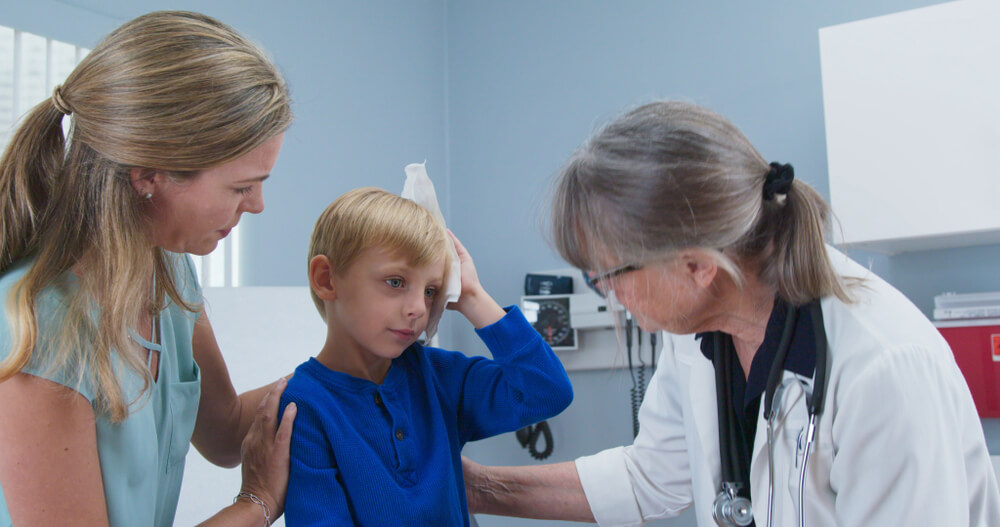A concussion can be best described as a mild traumatic brain injury (also called mild TB). These injuries usually occur when a blow to the head makes it move back and forth forcefully, causing specific chemical alterations in the brain, sometimes even damaging its cells.
While concussions in kids may seem concerning, children who follow the healthcare provider’s medical advice will usually experience their symptoms subsiding within a few weeks.
In this article, the expert team at Worldwide Pediatrics will elaborate on this topic, discussing the most prevalent signs of concussion in kids, concussion testing options, and more.
Concussion Symptoms in Kids
The most apparent sign of mild TB is that the patient loses consciousness, but that’s not always the case. Sometimes, children may receive a mild TB-inducing blow and still remain conscious.
As such, other signs of concussions may include the following:
- Seeing double or blurred vision
- Headaches
- Trouble walking, dizziness, balance issues
- Saying senseless things and confusion
- Difficulty answering questions or only addressing them slowly
- Vomiting or nausea
- Slurred speech
- Not recalling the blow itself
- Not feeling well
While most symptoms of a concussion in children can be observed immediately, some might take a few hours or days to show. Concussions in kids may also produce the following symptoms:
- Difficulty paying attention and focusing
- Memory problems and sudden learning challenges
- Headaches that get worse over time
- Sleep problems
- Feelings of anger, sadness, nervousness, or upset
If the following concussion symptoms in kids get worse after the injury, parents should go to the ER or call their healthcare provider immediately:
- The child passes out
- Constant severe headaches that only get worse
- Seizures
- Other problematic symptoms like continued vomiting
These are signs of more severe concussion requiring prompt and expert medical treatment in a hospital.
How Does a Concussion Happen?

The skull plays a pivotal role in protecting the brain from trauma, and the spinal fluid helps cushion the brain inside. A forceful jolt or blow to the head can directly injure the brain and make it move around the skull, banging up against the hard bone. The trauma changes the signals between the nerves, leading to concussion symptoms in children.
For the most part, these mild brain injuries happen to children and teens while they are playing sports. Those youngsters playing football, soccer, lacrosse, ice hockey, and field hockey are at the highest risk of concussions.
Still, these injuries can also result from:
- Hard falls
- Fights
- Bike or car accidents
How to Test for a Concussion?
How to test for a concussion following an injury? Most often, medical experts will perform the following tests to establish a diagnosis:
- Ask about the symptoms the child’s experiencing
- Ask about how the injury happened
- Perform brief concentration and memory tests
- Test the child’s reflexes, coordination, and balance
When the injury happens during a sports game, trainers or coaches may perform sideline concussion testing to see whether the athlete requires medical care or not. If an athlete suffers a head injury, they must stop playing immediately and should seek medical attention before returning to the field.
To help diagnose concussions in kids, sports leagues and schools often use baseline concussion testing that uses computer programs to test the injured child’s/athletes regular brain functions, checking memory, attention, and thinking speed.
Parents should also know that there are no visible mild concussion symptoms on CAT scans or MRIs. That said, doctors may only order brain scans when more severe problems accompany the injury, like:
- Continous headaches
- Worsening headaches
- When the damage was the result of a severe car accident or a nasty and high fall
Treatment for Concussions
Each child will recover from mild TBs at their own pace, and parents should ensure that there’s balance in the kid’s routine, meaning that they will be neither overwhelmed nor do too little.
First, the child should cut back on those activities that are overly physical or require too much concentration. Only after a while should they return to these activities. Also, you don’t have to wait for the concussion symptoms to be entirely gone for your child to add new activities to their schedules. Still, if the injury interferes with an everyday task, it’s best that the child takes a break from it and try it later, after a few minutes.
To make a full recovery, these steps can be vital:
Resting at Least for a Day or Two After the Injury
- Focus on calm activities like talking with friends and family, drawing, playing quiet games, coloring, reading, etc. If something seems too challenging, have the child take a break from it and try it again in a little while.
- Cut back on screen time. Texting, watching TV, playing video games, and using social media may worsen symptoms.
- Teens shouldn’t drive during this period.
- No physical activity and sports that can lead to a second injury.
- Help the child get adequate sleep.
Light Activity a Week After the Concussion
- The child may try more activities like watching TV or going for walks. If the symptoms interfere with something, it’s okay to take breaks.
- Following a few days, it’s okay for the child to go back to school. Working with the school team and the kid’s healthcare provider is essential to create an adequate return-to-school plan, starting with a lighter workload.
- Ensure that the child won’t engage in any sports or activities that may lead to a second injury at this point.
- The child should still get plenty of sleep.
- If headaches are still present, talk to your healthcare provider.
Introducing Moderate Activity (A Week or More After the Accident)

- When the symptoms are almost all gone, regular schoolwork can resume.
- The child should still avoid sports or activities that might lead to another injury.
- Breaks from activities if symptoms interfere are still advised.
Reintroducing Regular Activity a Month After the Injury
- When all symptoms are gone, the child can get back to all previous activities except sports.
- Regarding sports, doctors and trainers should work together to create a plan for returning to the field gradually. Only let your child return to sports if the healthcare expert says it’s okay.
A slow reintroduction to sports is essential to avoid risks of second-impact syndrome or another head injury before an adequate recovery from the first concussion. This may lead to lasting brain damage and may have even worse consequences.
Working With an Expert
We can’t keep our children and teenagers from engaging in what they love. Parents can always warn them about the dangers associated with certain sports and physical activity. Unfortunately, injuries can happen in every sport.
Also, parents can always work with experts to help avoid or treat any injuries or mishaps. That said, if you are looking for an experienced sports medicine doctor in Plantation and Doral, FL, feel free to schedule a consultation with us.



